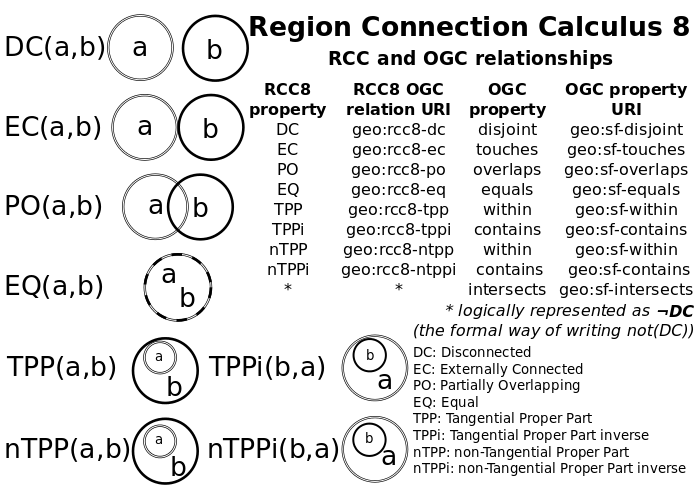OGC GeoSPARQL
GeoSPARQL is a standard for representation and querying of geospatial linked data for the Semantic Web from the Open Geospatial Consortium (OGC).[1] The definition of a small ontology based on well-understood OGC standards is intended to provide a standardized exchange basis for geospatial RDF data which can support both qualitative and quantitative spatial reasoning and querying with the SPARQL database query language.[2]
The Ordnance Survey Linked Data Platform uses OWL mappings for GeoSPARQL equivalent properties in its vocabulary.[3][4] The LinkedGeoData data set is a work of the Agile Knowledge Engineering and Semantic Web (AKSW) research group at the University of Leipzig,[5] a group mostly known for DBpedia, that uses the GeoSPARQL vocabulary to represent OpenStreetMap data.
In particular, GeoSPARQL provides for:
- a small topological ontology in RDFS/OWL for representation using
- Geography Markup Language (GML) and well-known text representation of geometry (WKT) literals, and
- Simple Features, RCC8, and DE-9IM (a.k.a. Clementini, Egenhofer) topological relationship vocabularies and ontologies for qualitative reasoning, and
- a SPARQL query interface using
- a set of topological SPARQL extension functions for quantitative reasoning, and
- a set of Rule Interchange Format (RIF) Core inference rules for query transformation and interpretation.
Example
The following example SPARQL query could help model the question "What is within the bounding box defined by 38.913574°N 77.089005°W and 38.886321°N 77.029953°W?"[6]
PREFIX geo: <http://www.opengis.net/ont/geosparql#>
PREFIX geof: <http://www.opengis.net/def/function/geosparql/>
SELECT ?what
WHERE {
?what geo:hasGeometry ?geometry .
FILTER(geof:sfWithin(?geometry,
"POLYGON((-77.089005 38.913574,-77.029953 38.913574,-77.029953 38.886321,-77.089005 38.886321,-77.089005 38.913574))"^^geo:wktLiteral))
}
RCC8 use in GeoSPARQL
RCC8 has been implemented in GeoSPARQL as described below:

Implementations
There are (almost) no complete implementations of GeoSPARQL, there are, however partial or vendor implementations of GeoSPARQL. Currently there are the following implementations:
- Apache Marmotta
- GeoSPARQL was implemented in the context of the Google Summer of Code 2015.[7] on Apache Marmotta; it uses PostGIS, and it is available just for PostgreSQL.
- Apache Jena
- Since version 2.11 Apache Jena has a GeoSPARQL extension.[8]
- Parliament
- Parliament has an almost complete implementation of GeoSPARQL by using JENA and a modified ARQ query processor.[9]
- Eclipse RDF4J
- Eclipse RDF4J is an open-source Java framework for scalable RDF processing, storage, reasoning and SPARQL querying. It offers support for a large subset of GeoSPARQL functionality.[10]
- Strabon
- Strabon is an open-source semantic spatiotemporal RDF store that supports two popular extensions of SPARQL: stSPARQL and GeoSPARQL. Strabon is built by extending the well-known RDF store Sesame and extends Sesame's components to manage thematic, spatial and temporal data that is stored in the backend RDBMS. It has been fully tested with PostgreSQL (with PostGIS and PostgreSQL-Temporal extensions[11]) and MonetDB (with geom[12] module).
- OpenSahara uSeekM IndexingSail Sesame Sail plugin
- uSeekM IndexingSail uses a PostGIS installation to deliver GeoSPARQL. They deliver partial implementation of GeoSPARQL along with some vendor prefixes.[13][14]
- Oracle Spatial and Graph
- GraphDB
- GraphDB is an enterprise ready Semantic Graph Database, compliant with W3C Standards. Semantic graph databases (also called RDF triplestores) provide the core infrastructure for solutions where modelling agility, data integration, relationship exploration and cross-enterprise data publishing and consumption are important.
- Stardog
- Stardog is an enterprise data unification platform built on smart graph technology: query, search, inference, and data virtualization.
Submission
The GeoSPARQL standard was submitted to the OGC by:
- Australian Bureau of Meteorology
- Bentley Systems
- Commonwealth Scientific and Industrial Research Organisation (CSIRO)
- Defence Geospatial Information Working Group (DGIWG)
- Natural Resources Canada
- Interactive Instruments GmbH
- Oracle America
- Ordnance Survey
- Raytheon
- Traverse Technologies
- US Geological Survey (USGS)
Related work
With regards to future work, the GeoSPARQL standard states:
Obvious extensions are to define new conformance classes for other standard serializations of geometry data (e.g. KML, GeoJSON). In addition, significant work remains in developing vocabularies for spatial data, and expanding the GeoSPARQL vocabularies with OWL axioms to aid in logical spatial reasoning would be a valuable contribution. There are also large amounts of existing feature data represented in either a GML file (or similar serialization) or in a datastore supporting the general feature model. It would be beneficial to develop standard processes for converting (or virtually converting and exposing) this data to RDF.
See also
References
- Battle & Kolas 2012, p. 355.
- Battle & Kolas 2012, p. 358.
- Goodwin, John (26 April 2013). "GeoSPARQL and Ordnance Survey Linked Data". John’s Weblog. External link in
|website=(help) - Gemma (3 June 2013). "New Linked Data service launches". Ordnance Survey Blog. External link in
|website=(help) - "Imprint". AKSW. 2012-05-18.
- Battle & Kolas 2012, p. 363.
- https://wiki.apache.org/marmotta/GSoC/2015/MARMOTTA-584
- [https://jena.apache.org/documentation/query/spatial-query.html
- http://parliament.semwebcentral.org/
- http://docs.rdf4j.org/programming/#_geosparql
- https://github.com/jeff-davis/PostgreSQL-Temporal
- https://www.monetdb.org/Documentation/Extensions/GIS
- "Archived copy". Archived from the original on 2014-04-15. Retrieved 2012-12-16.CS1 maint: archived copy as title (link)
- "Archived copy". Archived from the original on 2014-04-15. Retrieved 2014-04-14.CS1 maint: archived copy as title (link)
- Battle, Robert; Kolas, Dave (2012). "Enabling the Geospatial Semantic Web with Parliament and GeoSPARQL" (PDF). Semantic Web. IOS Press. 3 (4): 355–370. doi:10.3233/SW-2012-0065. Retrieved 21 November 2012.CS1 maint: ref=harv (link)
- Kyzirakos, Kostis; Karpathiotakis, Manos; Koubarakis, Manolis (November 2012). Strabon: A Semantic Geospatial DBMS (PDF). 11th International Semantic Web Conference. Boston, MA, United States. doi:10.1007/978-3-642-35176-1_19. Retrieved 21 November 2012.
- Usery, E. Lynn; Varanka, Dalia (2012). "Design and Development of Linked Data from The National Map" (PDF). Semantic Web. IOS Press. 3 (4): 371–384. doi:10.3233/SW-2011-0054. Retrieved 19 December 2012.CS1 maint: ref=harv (link)
- United States Geological Survey (30 May 2012). "Introduction to geospatial semantics and technology workshop handbook: U.S. Geological Survey Open-File Report 2012–1109" (PDF). United States Geological Survey. Retrieved 18 December 2012.
- Goad, Chris (September 2004). "RDF versus GML". Archived from the original on 22 April 2012. Retrieved 4 December 2012.
External links
- GeoSPARQL – A Geographic Query Language for RDF Data standard from the Open Geospatial Consortium
- Linked Data Platform webapps from the UK Ordnance Survey
- LinkedGeoData for OpenStreetMap data
- data.geohive.ie from Ordnance Survey Ireland